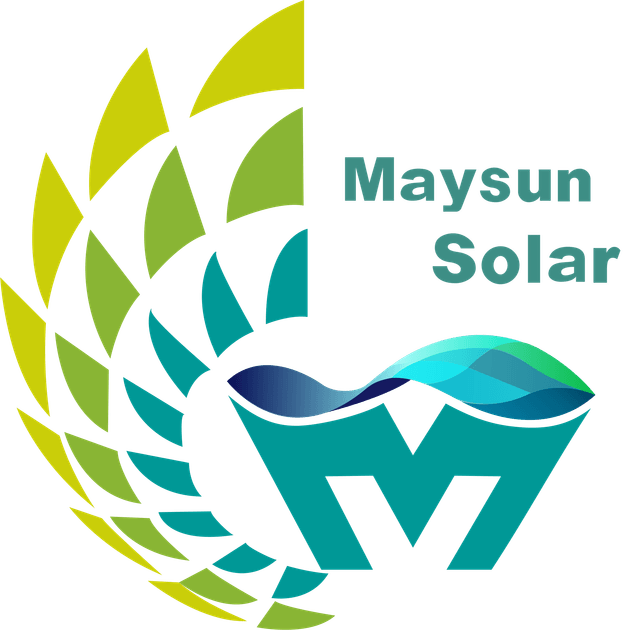
Maysun Solar
- …
Maysun Solar
- …
What is solar module IBC technology?
What is IBC photovoltaic module technology?

What is IBC Technology?
- The IBC (Interdigitated Back Contact) cell is a type of back junction where positive and negative metal electrodes are arranged in the shape of forked fingers on the rear side of the cell, away from direct light.
- In the structure of these rear contact solar cells, the P-N junction is located at the back of the cell, and the current follows a two-dimensional transmission model.
- MWT (Metal Wrap Through) and EWT (Emitter Wrap Through) also fall under the category of back contact solar cells. However, since their P-N junctions are on the front of the cell, they are referred to as front junction back contact solar cells.
Structure of IBC Solar Cells
The main layer of IBC solar cells is the n-type or p-type c-Si wafer serving as the absorption layer. This layer is created by doping the c-Si layer with boron or phosphorus to produce p-type or n-type doped wafers. Subsequently, an anti-reflective and passivation coating made of SiO is usually applied on one or both sides of the solar cell.
Key structural variations in IBC solar cells include the introduction of a diffusion layer characterized by intersecting n-type and p-type layers, allowing for the installation of back-side metal contacts.
In the final step, each metal contact of the IBC solar cell is placed on the back of the cell, ensuring the front of the cell is completely free of shading material. This also allows for wider placement of contacts, thereby reducing the cell's series resistance.

The majority of IBC solar cells primarily consist of c-Si wafers as the n-type wafer absorption layer, though p-type wafers are also used. Monocrystalline silicon (mono c-Si) is the most common choice due to its higher efficiency, but polycrystalline silicon (poly c-Si) can also be used.
An anti-reflective and passivation layer is coated on one or both sides of the c-Si wafer, using a thin layer of silicon dioxide (SiO2) applied through a thermal oxidation process. Other suitable materials such as silicon nitride (SiNx) or boron nitride (BNx) can also be used.
To reposition the front contacts to the back of the IBC solar cell, distributed or intersecting n+ and p+ emitter layers, also known as diffusion layers, need to be introduced. To manufacture these layers, processes like masked diffusion, ion implantation, or laser doping with boron are applied to the n-type wafer, creating p-type doped regions while maintaining the integrity of the n-type layer.
The metal contacts can be placed using laser ablation or wet chemical deposition methods, with commonly used metal materials including silver, nickel, or copper, serving as contacts for the IBC solar cells.

Working Principle of IBC Solar Cells
IBC solar cells, similar to Al-BSF solar cells, generate solar power through the photovoltaic effect. The load is connected between the positive and negative terminals of the IBC solar cell panel, converting photons into electrical energy, thus providing solar power to the load.
Like traditional solar cells, photons impact the absorption layer of IBC solar cells, thereby exciting electrons and creating electron-hole pairs (e-h). Since IBC solar cells do not have metal contacts shading the front of the cell, these solar cells have a larger area for photon impact conversion.
The electron-hole pairs formed at the front of the IBC solar cells are then collected by the p-type interdigitated layer at the back. The collected electrons flow from the p-type metal contact to the load, generating electricity, and then return to the IBC solar cell through the n+ metal contact, completing the specific e-h cycle.
Manufacturing Processes for IBC Cells
Perc, TOPCon, and IBC Technologies Compared

Advantages of IBC Technology
- The front of the cell has no metal line shielding, which can eliminate current loss due to metal electrode shading and maximize the utilization of incident photons. Compared to conventional solar cells, the short circuit current can be increased by about 7%.
- The positive and negative electrodes are on the back of the cell, making grid line shielding unnecessary. The size of the grid lines can be suitably increased to reduce series resistance and improve the fill factor (FF).
- Surface passivation and the surface trapping structure can be optimized to reduce the front surface recombination rate and surface reflection, thereby improving open-circuit voltage (VOC) and short-circuit current density (JSC), as the front side does not have concerns like line shading or metal contact.
- Aesthetically pleasing and particularly suitable for integration into photovoltaic buildings, offering good commercial prospects.
Development direction of IBC solar cell efficiency
IBC solar cells utilise leading-edge Interdigitated Back Contact technology by strategically placing contacts on the back side to minimise shading and current losses, resulting in unparalleled energy conversion efficiency.


Low temperature coefficient
IBC solar panels show greater stability in high-temperature environments compared to traditional panels(temperature coefficient of -0.29%/℃). Their design minimises internal resistance and heat loss, which helps maintain higher conversion efficiency under elevated temperatures.
Forecast of Future Development of IBC Solar Cells
Kopecek told PV Magazine, 'By 2028, IBC solar modules could replace TOPCon, the current main product of the market.' The transition to IBC products could begin as early as 2025, and by 2030, traditional products may gradually phase out of the market.
Kopecek expressed that the global market share of IBC solar modules is expected to rise from about 2% in 2022 to around 6% by 2026, possibly reaching 20% by 2028, and exceeding 50% by 2030.
Reference:
https://www.pv-magazine.de/2022/11/03/zelltechnologie-ibc-koennte-topcon-bis-2028-vom-markt-verdraengen/
https://solarmagazine.com/solar-panels/ibc-solar-cells/
https://www.energiemagazin.com/photovoltaik/ibc-technologie-solarzellen/
Maysun IBC Solar module
Recommended Articles of IBC Technology
Learn More Technology






Half-Cut
Bifacial
IBC
TOPCon
HJT
Shingled
Copyright © 2011 - 2024 Maysun Solar. All rights reserved.













